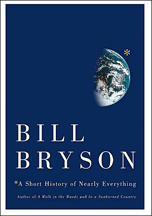 |
| |
|||
| Posted on Sun, Aug. 31, 2003 | |||
Travel writer Bill Bryson conducts engaging tour of 'nearly everything'
A Short History of Nearly Everything If this is Tuesday, it must be Betelgeuse. Or could it be Olduvai Gorge? There is no need to worry about missing any important sites because Bill Bryson's A Short History of Nearly Everything is the ultimate guide to the universe, taking you from the outer reaches of the cosmos to the mysterious molten interior of the Earth, and then into the even deeper, helically twisted landscape of our DNA. Covering 20 billion light-years in just 544 pages, best-selling travel writer Bryson here relates his quest for knowledge about who, what, and where we are and, more important, how we know these things. The simple question "How does anybody know how much the Earth weighs?" leads Bryson to visit stranger lands than even he has visited before. Thus a short list of "nearly everything" includes cosmology, geology, astronomy, astrophysics, botany, vulcanology, anthropology, paleontology, etymology, archaeology, climatology, and evolutionary and cellular biology. In less capable hands, this would be a collection of encyclopedia entries. With his keen and wonderfully humorous perspective, Bryson has written the best kind of travelogue - one in which each stop on the itinerary is fascinating because he settles in and stays awhile, unearthing the stories and myths of the local denizens. And there can't be a more colorful, bizarre, and eccentric class of locals than the scientists whose lives and obsessions Bryson chronicles. We should all know that Henry Cavendish, the 18th-century physicist instrumental in measuring the mass of the Earth, was so shy that he communicated with his housekeeper by letter. Or that Carl Linné, the Swedish naturalist, scandalized his colleagues with his predilection for naming species with sexual suggestiveness. Then there is ocean-diving pioneer J.B.S. Haldane, who, in a personal commitment to the scientific method, caused a fit so severe that he crushed several of his vertebrae while investigating the poisoning effects of elevated levels of oxygen. Make no mistake: This book contains real science. And Bryson, despite self-deprecation about his scientific acumen, is definitely a first-rate teacher, able to put difficult concepts into perspective. Consider the Rev. Bob Evans, an Australian minister who searches for supernovas using only a small telescope in his backyard. To illustrate Evans' Rain Man-like ability to memorize the position of thousands of stars and recognize the new light of a supernova, Bryson describes a Wal-Mart parking lot covered with 1,500 dining-room tables, each splashed with a random amount of salt. "Now add one grain of salt to any table... . At a glance [Evans] will spot it. That grain of salt is the supernova." As in his best-seller A Walk in the Woods, Bryson does not just string together a collection of amusing anecdotes. There is a purpose here, and it is to tell the story of how we arrived on the cosmic scene and how, without care, we might just wipe ourselves out of that scene. "As far as we can tell, we are the best there is. We may be all there is. It's an unnerving thought that we may be the living universe's supreme achievement and its worst nightmare simultaneously." The best travel writing takes you along on the journey, where you meet the same guides and sample the same food. You want to go back again not because you missed a site, but because of the liberating knowledge you gain from the people along the way. With Bryson's A Short History of Nearly Everything, you will undoubtedly want to go back to spend that evening down under with the Rev. Evans looking for supernovas way up above. Richard Di Dio teaches mathematics and physics at La Salle University. |
|||
